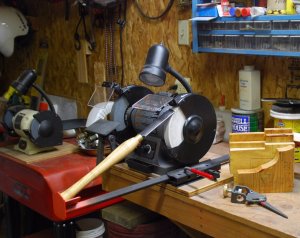First some background info....My son & I have been turning pens for two years. Generally no problem sharpening or turning acrylics until recently. Over the past 2 - 3 months we've been getting a lot of blow outs with acrylics. I really think it's my sharpening. In terms of skill, I know I'm lacking, and in terms of equipment, what we're using is inferior.
The chisels I am sharpening are HSS BB penturning set and HF full size set. The sharpening setup is a HF 6" dry / 8" wet bench grinder. I hardly use the wet wheel as it has not tool platform. The 6" wheel is, presumably the one that came with the grinder (inherited from my father). I have basically sharpened the BB penturners roughing gouge down to a nub in the past two years. I'm sure the wheel is much too aggressive. The tool platform on the grinder is pathetic and I don't get a consistent and sharp bevel on my tools. Really, the fun has gone out of turning now, because we are constantly anticipating losing blanks to blowouts. I need to remedy the situation.
My plan is to definitely buy the Oneway Wolverine Sharpening System (v-holder and platform).
My questions are:
1) Can I stay with the HF grinder and upgrade the wheel to a Norton 3x 80 grit?
2) If I absolutely have to, I am thinking of buying the Delta 23-199 variable speed 8" grinder. Any experience with this?
3) I would change to Norton wheels for the 8" grinder. Are 80 and 120 grit appropriate?
I really need to learn to sharpen and get a proper setup as we are both getting frustrated. I appreciate any input.
Thanks.
My problems, as I see them is we get a lot of chatter and catches on acrylics. Again, more in the past 2 - 3 months
The chisels I am sharpening are HSS BB penturning set and HF full size set. The sharpening setup is a HF 6" dry / 8" wet bench grinder. I hardly use the wet wheel as it has not tool platform. The 6" wheel is, presumably the one that came with the grinder (inherited from my father). I have basically sharpened the BB penturners roughing gouge down to a nub in the past two years. I'm sure the wheel is much too aggressive. The tool platform on the grinder is pathetic and I don't get a consistent and sharp bevel on my tools. Really, the fun has gone out of turning now, because we are constantly anticipating losing blanks to blowouts. I need to remedy the situation.
My plan is to definitely buy the Oneway Wolverine Sharpening System (v-holder and platform).
My questions are:
1) Can I stay with the HF grinder and upgrade the wheel to a Norton 3x 80 grit?
2) If I absolutely have to, I am thinking of buying the Delta 23-199 variable speed 8" grinder. Any experience with this?
3) I would change to Norton wheels for the 8" grinder. Are 80 and 120 grit appropriate?
I really need to learn to sharpen and get a proper setup as we are both getting frustrated. I appreciate any input.
Thanks.
My problems, as I see them is we get a lot of chatter and catches on acrylics. Again, more in the past 2 - 3 months

